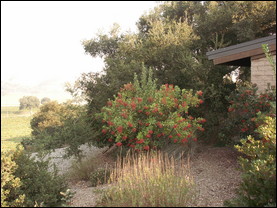 A successfully xeriscaped garden in Santa Barbara, California. |
Saving water can begin at home. The basic principle is to reduce the total square-foot area of high-water-use plants and increase the areas of plants that require less or no supplemental watering. Start by analyzing the square footage of various kinds of plants — lawn, shrubs, ground covers, wild area, trees.
Proceed by looking around at areas where there is no irrigation to see what plants are growing well. Make a list of those that appeal to you. When redesigning, plan for a sequence of bloom so that there are interesting flowers, shapes, greenery or natural forms at all seasons. Rocks, dried wood, mulches, statues and furniture all can be elements in a garden, not just the plants. Choose the plants carefully for low water requirements and think of their architectural shapes as well as their brief flowering periods. You should like them. There is no reason to live with cactus if you hate it!
Finally analyze how much of your current plant material can be exchanged for lower-water-use plants. Start with the lawn. Can some of the lawn be taken for ground cover and shrubs, or ground cover and trees? You may want to keep some lawn for aesthetics or to use, but do you need all of it? Can you let it go brown during the dry season? (If so, be sure it is mowed short and is not a fire hazard.)
After determining how much labor-intensive, thirsty lawn you really need and want, consider what to do with the water-guzzling varieties of shrubs and trees. A thoughtful analysis will probably show that many of the existing plants will survive well with minimal or no supplemental water. Carefully planned landscapes need supplemental watering only during times of severe drought.
Finally, look at the borders of the property. Identify which of the screen or shade trees require a lot of water. Should you begin to replace them with drought-resistant species? As the new small plants grow larger, the old ones may be left to decline. It can take a while accomplish the change-over to low-water-use plantings, often a period of years.
Most people who like to garden are usually not content with only drought-resistant plants. They need flowers and fruits and their old favorites. Consider transplanting your favorite high-water-use trees, shrubs and flowers to one area where they can be given extra water, instead of having them mixed in with the other more drought-resistant ones. If you can direct the roof runoff water into this special bed, it will maximize the use of your available rainfall and lower the need for supplement water. (see diagram)
Xeriscaping does not mean that water cannot be used ever. It aims to lower the total water use. Some parts of the garden will use a fair amount of water, while others will be low-or medium-use areas.
 Using roof water from gutters and downspouts is a great way to conserve water. |
Conserving Water
To conserve water, consider using "gray water" drained from your dishwasher or washing machine for irrigation instead of sending it down the sewer. Of course, use roof water from gutters and downspouts, which can be directed into irrigation systems or rain barrels. If water restrictions become severe, a big pan in the kitchen sink will catch any water used, which can then be emptied on a favorite plant bed if it’s not too far from the kitchen door.
Another water-saving technique is to put flowers in pots or planters, rather than in the ground. It takes less water to keep a planter wet than an equal volume of soil in the ground. Peat moss or synthetic water-grabbing polymers can be used to help the planting mix absorb and hold more water. Then they release it slowly to the plant roots. The more water that’s absorbed, the less often the planters have to be watered. Some flowers survive on less water than others, and eventually one gets to know which they are.
"Pillow Planting" is another useful technique. Place a small plastic bag of loose moist peat moss (not a compressed bale) on its side in a planter or big flowerpot. The plastic bag the peat comes in is the easiest to use. Punch some holes in the bottom of the bag, slash Xs in the top of the bag and saturate the peat moss with water. Into each X hole, place the root ball of the plant. Each planting pillow can have many plants tucked into it.
Because the peat moss absorbs so much water, it doesn’t dry out as fast as the plant root ball would in its own pot or the ground. But peat moss has no nutrients, so regular fertilizer is easiest and most reliable and a 20-20-20 formulation gives the most flowers. Organic fertilizer is more environmentally correct but it has to be applied carefully. If too concentrated in the small planting hole, it can be too strong for the roots.
An economic analysis of the cost savings realized from xeriscaping was done for a house with irrigation in Atlanta, Georgia, an area with good rainfall. The existing landscape was renovated to conserve water use. New plants would cost $1,245. During the first year, however, the renovation would save $112 on water and sewer costs, $237 on maintenance expense, and would use 27,000 fewer gallons of water. As the new plantings matured, yearly savings would increase. It was estimated the total outlay of $1,245 would be recouped in three years as a result of these savings.
Credit: www.mothersgarden.net




























